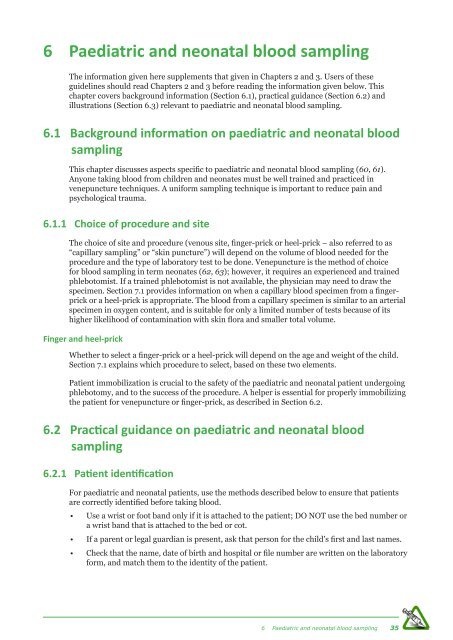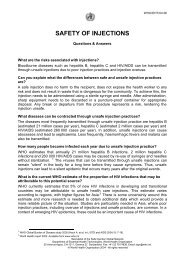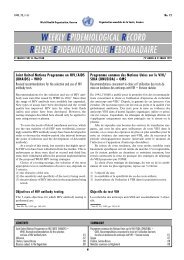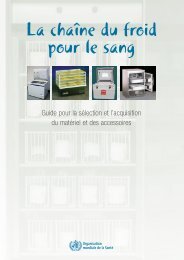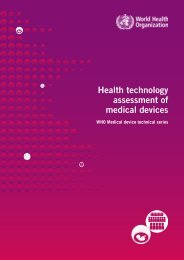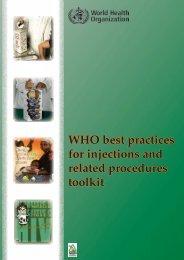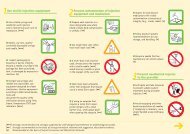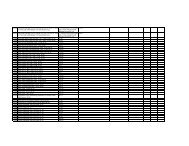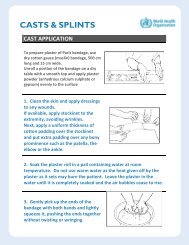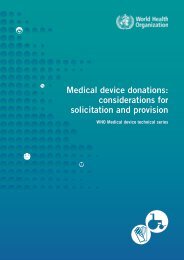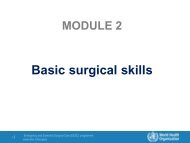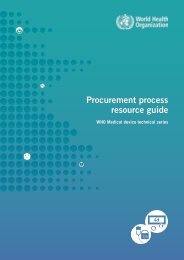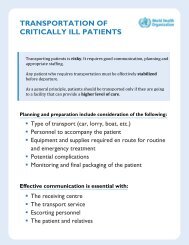WHO Guidelines on Drawing Blood: Best Practices in Phlebotomy
WHO Guidelines on Drawing Blood: Best Practices in Phlebotomy
WHO Guidelines on Drawing Blood: Best Practices in Phlebotomy
- No tags were found...
You also want an ePaper? Increase the reach of your titles
YUMPU automatically turns print PDFs into web optimized ePapers that Google loves.
6 Paediatric and ne<strong>on</strong>atal blood sampl<strong>in</strong>g<br />
The <strong>in</strong>formati<strong>on</strong> given here supplements that given <strong>in</strong> Chapters 2 and 3. Users of these<br />
guidel<strong>in</strong>es should read Chapters 2 and 3 before read<strong>in</strong>g the <strong>in</strong>formati<strong>on</strong> given below. This<br />
chapter covers background <strong>in</strong>formati<strong>on</strong> (Secti<strong>on</strong> 6.1), practical guidance (Secti<strong>on</strong> 6.2) and<br />
illustrati<strong>on</strong>s (Secti<strong>on</strong> 6.3) relevant to paediatric and ne<strong>on</strong>atal blood sampl<strong>in</strong>g.<br />
6.1 Background <strong>in</strong>formati<strong>on</strong> <strong>on</strong> paediatric and ne<strong>on</strong>atal blood<br />
sampl<strong>in</strong>g<br />
This chapter discusses aspects specific to paediatric and ne<strong>on</strong>atal blood sampl<strong>in</strong>g (60, 61).<br />
Any<strong>on</strong>e tak<strong>in</strong>g blood from children and ne<strong>on</strong>ates must be well tra<strong>in</strong>ed and practiced <strong>in</strong><br />
venepuncture techniques. A uniform sampl<strong>in</strong>g technique is important to reduce pa<strong>in</strong> and<br />
psychological trauma.<br />
6.1.1 Choice of procedure and site<br />
The choice of site and procedure (venous site, f<strong>in</strong>ger-prick or heel-prick – also referred to as<br />
“capillary sampl<strong>in</strong>g” or “sk<strong>in</strong> puncture”) will depend <strong>on</strong> the volume of blood needed for the<br />
procedure and the type of laboratory test to be d<strong>on</strong>e. Venepuncture is the method of choice<br />
for blood sampl<strong>in</strong>g <strong>in</strong> term ne<strong>on</strong>ates (62, 63); however, it requires an experienced and tra<strong>in</strong>ed<br />
phlebotomist. If a tra<strong>in</strong>ed phlebotomist is not available, the physician may need to draw the<br />
specimen. Secti<strong>on</strong> 7.1 provides <strong>in</strong>formati<strong>on</strong> <strong>on</strong> when a capillary blood specimen from a f<strong>in</strong>gerprick<br />
or a heel-prick is appropriate. The blood from a capillary specimen is similar to an arterial<br />
specimen <strong>in</strong> oxygen c<strong>on</strong>tent, and is suitable for <strong>on</strong>ly a limited number of tests because of its<br />
higher likelihood of c<strong>on</strong>tam<strong>in</strong>ati<strong>on</strong> with sk<strong>in</strong> flora and smaller total volume.<br />
F<strong>in</strong>ger and heel-prick<br />
Whether to select a f<strong>in</strong>ger-prick or a heel-prick will depend <strong>on</strong> the age and weight of the child.<br />
Secti<strong>on</strong> 7.1 expla<strong>in</strong>s which procedure to select, based <strong>on</strong> these two elements.<br />
Patient immobilizati<strong>on</strong> is crucial to the safety of the paediatric and ne<strong>on</strong>atal patient undergo<strong>in</strong>g<br />
phlebotomy, and to the success of the procedure. A helper is essential for properly immobiliz<strong>in</strong>g<br />
the patient for venepuncture or f<strong>in</strong>ger-prick, as described <strong>in</strong> Secti<strong>on</strong> 6.2.<br />
6.2 Practical guidance <strong>on</strong> paediatric and ne<strong>on</strong>atal blood<br />
sampl<strong>in</strong>g<br />
6.2.1 Patient identificati<strong>on</strong><br />
For paediatric and ne<strong>on</strong>atal patients, use the methods described below to ensure that patients<br />
are correctly identified before tak<strong>in</strong>g blood.<br />
• Use a wrist or foot band <strong>on</strong>ly if it is attached to the patient; DO NOT use the bed number or<br />
a wrist band that is attached to the bed or cot.<br />
• If a parent or legal guardian is present, ask that pers<strong>on</strong> for the child’s first and last names.<br />
• Check that the name, date of birth and hospital or file number are written <strong>on</strong> the laboratory<br />
form, and match them to the identity of the patient.<br />
6 Paediatric and ne<strong>on</strong>atal blood sampl<strong>in</strong>g 35


